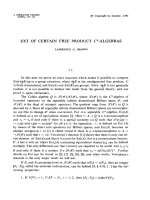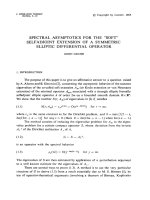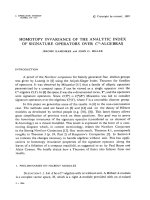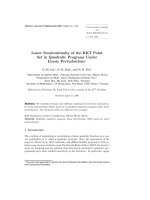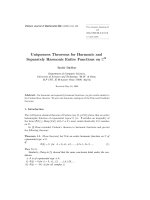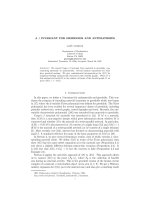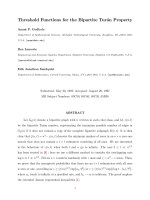Báo cáo toán học: "Lower bounds for the football pool problem for 7 and 8 matches" pdf
Bạn đang xem bản rút gọn của tài liệu. Xem và tải ngay bản đầy đủ của tài liệu tại đây (131.57 KB, 12 trang )
Lower bounds for the football pool
problem for 7 and 8 matches
Wolfgang Haas
Albert-Ludwigs-Universit¨at
Mathematisches Institut
Eckerstr. 1
79104 Freiburg, Germany
wolfgang
Submitted: Oct 26, 2006; Accepted: Mar 15, 2007; Published: Mar 28, 2007
Mathematics Subject Classifications: 94B65
Abstract
Let k
3
(n) denote the minimal cardinality of a ternary code of length n and
covering radius one. In this paper we show k
3
(7) ≥ 156 and k
3
(8) ≥ 402 improving
on the best previously known bounds k
3
(7) ≥ 153 and k
3
(8) ≥ 398. The proofs
are founded on a recent technique of the author for dealing with systems of linear
inequalities satisfied by the number of elements of a covering code, that lie in k-
dimensional subspaces of F
n
3
.
1 Introduction
Let F
3
= {0, 1, 2} denote the finite field with three elements. The Hamming distance
d(λ, µ) between λ = (x
1
, , x
n
) ∈ F
n
3
and µ = (y
1
, , y
n
) ∈ F
n
3
is defined by
d(λ, µ) = |{i ∈ {1, , n} : x
i
= y
i
}|.
The subset C ⊂ F
n
3
is called a ternary code with covering radius (at most) one, if
∀λ ∈ F
n
3
∃µ ∈ C with d(λ, µ) ≤ 1 (1)
holds. For a monograph on covering codes see [1]. The problem to determine k
3
(n), the
minimal cardinality of a ternary code with covering radius one is known as the “football
pool problem” and was widely studied during the last decades. Updated bounds for k
3
(n)
are contained in an internet table by K´eri [7].
The easy bound
k
3
(n) ≥
3
n
2n + 1
the electronic journal of combinatorics 14 (2007), #R27 1
is known as the sphere covering bound. In the recent papers [2], [3] the author developed
a new technique (based on a method of Habsieger [4]) to improve on the sphere covering
bound by dealing with systems of linear inequalities satisfied by the number of elements
of C, that lie in k-dimensional subspaces of F
n
3
. The method presented in [3] is limited
by k ≈
n
2
. The reason is, that for larger values of k the “irregular” solutions of the linear
inequalities no longer yield a negligible amount in the necessary estimations.
The aim of this paper is to present a first method to deal with these irregularities. We
consider the cases n = 7 and n = 8 (with k = 4 resp. k = 5). In the case n = 7 the best
previously known lower bound k
3
(7) ≥ 153 is due to Habsieger [5]. We show
Theorem 1. k
3
(7) ≥ 156.
For the case of 8 matches the best lower bound k
3
(8) ≥ 398 is due to Habsieger, Plagne
[6] and the author [3]. Here we show
Theorem 2. k
3
(8) ≥ 402.
In section 2 we state the system of linear inequalities mentioned above (Lemma 1) and
limit the degree of irregularity of its solutions (Lemma 2). In section 3 we start with some
preliminaries. Section 4 contains a proof of k
3
(7) ≥ 155. The more detailed considerations
needed to prove Theorem 1 are contained in section 5. In section 6 we prove Theorem 2.
We remark, that the proofs in this paper do not use any computer calculations.
2 The covering inequalities
The definitions in this section are used in the whole paper. We say that µ ∈ F
n
3
1-covers
λ ∈ F
n
3
if d(λ, µ) ≤ 1. For σ ∈ F
k
3
and 1 ≤ j ≤ k (≤ n) we define one-dimensional
subspaces of F
k
3
(lines) by
L(σ, j) = {ρ ∈ F
k
3
: ρ and σ differ at most in the jth coordinate},
L = {L(σ, j) : σ ∈ F
k
3
, 1 ≤ j ≤ k}.
It is clear, that |L| = 3 holds for all L ∈ L. Apparently L(σ
2
, j
2
) = L(σ
1
, j
1
) is equivalent
to j
2
= j
1
and σ
2
∈ L(σ
1
, j
1
). This implies
|{L ∈ L : σ ∈ L}| = k for each σ ∈ F
k
3
(2)
and
|L| = k3
k−1
. (3)
If x
σ
is a nonnegative integer for each σ ∈ F
k
3
, we say that the triple (x
σ
, x
ρ
, x
τ
) is the
value distribution of the line L = {σ, ρ, τ} ∈ L. We write
g(L) =
σ∈L
x
σ
for each L ∈ L,
the electronic journal of combinatorics 14 (2007), #R27 2
L
i
= {L ∈ L : max
σ∈L
x
σ
= i}, L
≥i
=
j≥i
L
j
for i ≥ 0. (4)
For λ ∈ F
n
3
we define h
k
(λ) ∈ F
k
3
(1 ≤ k ≤ n) by
h
k
(λ) = (x
1
, , x
k
) if λ = (x
1
, , x
k
, , x
n
).
Now assume C ⊂ F
n
3
is a ternary code. For σ ∈ F
k
3
(1 ≤ k ≤ n) we set
A
σ
= {λ ∈ F
n
3
: h
k
(λ) = σ}, n
σ
= |C ∩ A
σ
|. (5)
Finally we set
k
i
= |{σ ∈ F
k
3
: n
σ
= i}| for i ≥ 0.
Lemma 1A (Habsieger [4]) If C ⊂ F
n
3
has covering radius one and k = n − 3 we
have
7n
σ
+
ρ∈F
k
3
,d(ρ,σ)=1
n
ρ
≥ 27 for σ ∈ F
k
3
. (6)
Proof. By (1) the 27 elements of A
σ
have to be 1-covered by C. This can be done
only by the elements of C ∩ A
σ
and C ∩ A
ρ
with ρ ∈ F
k
3
, d(ρ, σ) = 1. Since each element
of C ∩ A
σ
1-covers 7 elements of A
σ
and each element of C ∩ A
ρ
one, (6) follows.
Lemma 1B If C ⊂ F
n
3
has covering radius one and k = n − 3 we have
L∈L:σ∈L
g(L) ≥ 27 − (7 − k)n
σ
for σ ∈ F
k
3
concerning the numbers n
σ
defined in (5).
Proof. By (2) we have
L∈L:σ∈L
g(L) = kn
σ
+
ρ∈F
k
3
,d(ρ,σ)=1
n
ρ
= 7n
σ
+
ρ∈F
k
3
,d(ρ,σ)=1
n
ρ
− (7 − k)n
σ
for σ ∈ F
k
3
and Lemma 1B follows from Lemma 1A.
We now show, that large values of n
σ
cannot occur “too often”.
Lemma 2 Assume C ⊂ F
n
3
is a ternary code with covering radius one and k =
n − 3. Moreover assume that, after a suitable permutation of the coordinates of the code,
whenever ρ ∈ F
k
3
with n
ρ
≥ 5, then the set C ∩ A
ρ
1-covers at most s from the 27 elements
of A
ρ
. Then
k
4
+
i≥5
(7i − s)k
i
≤ 6|C| − 3
3
n
− |C|
n
− min
3, 3
n
− |C| − n
3
n
− |C|
n
.
the electronic journal of combinatorics 14 (2007), #R27 3
Proof. For 1 ≤ i ≤ n we set
C
i
= {λ ∈ F
n
3
\ C : ∃µ ∈ C (λ and µ differ exactly in the ith coordinate)}.
By (1) we have F
n
3
\ C =
1≤i≤n
C
i
. We choose pairwise disjoint sets C
i
(1 ≤ i ≤ n)
satisfying C
i
⊂ C
i
(1 ≤ i ≤ n) and
1≤i≤n
C
i
=
1≤i≤n
C
i
. After a suitable permutation of
the coordinates of the code we may assume |C
1
| ≤ |C
2
| ≤ ≤ |C
n
|. Write 3
n
−|C| = qn+r
with integers q, r and 0 ≤ r < n. We find
3q + min{3, r} ≤ |C
n−2
∪ C
n−1
∪ C
n
|. (7)
Assume to the contrary |C
n−2
∪C
n−1
∪C
n
| < 3q+min{3, r}. Then |C
n−2
|+|C
n−1
|+|C
n
| ≤
|C
n−2
∪ C
n−1
∪ C
n
| < 3q + 3 implying |C
n−2
| ≤ (|C
n−2
| + |C
n−1
| + |C
n
|)/3 ≤ q and thus
qn + r = |F
n
3
\ C| = |
1≤i≤n
C
i
| = |C
1
| + + |C
n
| ≤ (n − 3)|C
n−3
| + |C
n−2
∪ C
n−1
∪ C
n
| <
(n − 3)q + 3q + min{3, r} ≤ qn + r, a contradiction.
Now for σ ∈ F
k
3
we set
S(σ) = {λ ∈ A
σ
\ C : λ is 1-covered by C ∩ A
σ
}.
We then have C
n−2
∪ C
n−1
∪ C
n
=
σ∈F
k
3
S(σ). Since µ ∈ C ∩ A
σ
1-covers at most 6
elements from A
σ
\ C and |A
σ
| = 27 we have |S(σ)| ≤ min{6n
σ
, 27 − n
σ
}. Moreover, if
n
σ
≥ 5, by the proposition of the Lemma we may use the estimation |S(σ)| ≤ s − n
σ
. We
now find
|C
n−2
∪ C
n−1
∪ C
n
| ≤
σ∈F
k
3
|S(σ)| =
1≤i≤3
σ∈F
k
3
n
σ
=i
|S(σ)| +
σ∈F
k
3
n
σ
=4
|S(σ)| +
i≥5
σ∈F
k
3
n
σ
=i
|S(σ)|
≤ 6
1≤i≤3
ik
i
+ 23k
4
+
i≥5
(s − i)k
i
= 6
i≥1
ik
i
− k
4
−
i≥5
(7i − s)k
i
= 6|C| − k
4
−
i≥5
(7i − s)k
i
and Lemma 2 follows by (7), q =
3
n
−|C|
n
and r = 3
n
− |C| − qn.
Lemma 3 If C ⊂ F
7
3
is a ternary code with covering radius one, |C| ≤ 155 and
k = 4, then without loss of generality we may assume
k
5
+ 2k
6
+ 3
i≥7
k
i
≤ 7.
Proof. After a suitable permutation of the coordinates of the code (which does not affect
the covering radius) we may apply Lemma 2 with n = 7 and s = 27 and get
8k
5
+ 15k
6
+ 22k
7
+ 29
i≥8
k
i
≤ 58. (8)
Multiplication with 3/22 and rounding off yields Lemma 3.
the electronic journal of combinatorics 14 (2007), #R27 4
3 Some preliminaries
Assume C ⊂ F
n
3
is a ternary code with covering radius one and k = n − 3. We set
B
i
= {σ ∈ F
k
3
: n
σ
= i} for i = 0, 1,
B = B
0
∪ B
1
and
K
i
= {L ∈ L : |L ∩ B| = i} for 0 ≤ i ≤ 3.
Let c be a constant integer with c ∈ {5, 6}. We set
g
∗
(L) = g(L) − c for L ∈ L. (9)
We find
L∈L
g
∗
(L) =
0≤i≤3
L∈K
i
g
∗
(L) (10)
=
1
2
1≤i≤3
i
L∈K
i
g
∗
(L) +
1
2
L∈K
1
g
∗
(L) −
1
2
L∈K
3
g
∗
(L) +
L∈K
0
g
∗
(L)
=
1
2
σ∈B
L∈L,σ∈L
g
∗
(L) +
1
2
σ∈B
L∈K
1
,σ∈L
g
∗
(L) −
1
2
L∈K
3
g
∗
(L) +
L∈K
0
g
∗
(L),
because in the sum
σ∈B
L∈L,σ∈L
g
∗
(L) every g
∗
(L) with L ∈ L and |L ∩ B| = i
(1 ≤ i ≤ 3) is counted exactly i times. We now set
B
∗
=
σ ∈ B :
L∈L,σ∈L
g
∗
(L) +
L∈K
1
,σ∈L
g
∗
(L) < 0
. (11)
By c ∈ {5, 6} we have g
∗
(L) ≤ −2 for L ∈ K
3
and g
∗
(L) ≥ 0 for L ∈ K
0
. Thus from (10)
and (11) now follows
L∈L
g
∗
(L) ≥
1
2
σ∈B
∗
L∈L,σ∈L
g
∗
(L) +
L∈K
1
,σ∈L
g
∗
(L)
. (12)
4 Proof of k
3
(7) ≥ 155
Assume C ⊂ F
7
3
is a ternary code of covering radius one with |C| ≤ 155. We set k = 4
and choose c = 6 in (9). In this section we show
L∈L
g
∗
(L) ≥ −28. (13)
the electronic journal of combinatorics 14 (2007), #R27 5
This suffices for a proof of the bound k
3
(7) ≥ 155. Assume (for the moment) |C| ≤ 154.
We have
4|C| = 4
σ∈F
4
3
n
σ
=
σ∈F
4
3
n
σ
L∈L,σ∈L
1 =
L∈L
g(L)
=
L∈L
g
∗
(L) + 6
L∈L
1 ≥ −28 + 6 · 108
by (2), (3), (9) and (13) and thus |C| ≥ 155, a contradiction. In the same way we get the
bound k
3
(7) ≥ 156 if we are able to show that equality cannot hold in (13). This requires
a more detailed analysis and is postponed to the next section. The reader interested
in this bound should keep track about some consequences of assumed equality in (13)
throughout this and the previous section. These consequences are listed in the beginning
of section 5.
We now show (13). From Lemma 1B and (2) we get
L∈L,σ∈L
g
∗
(L) ≥ 0 for σ ∈ B
1
, (14)
L∈L,σ∈L
g
∗
(L) ≥ 3 for σ ∈ B
0
. (15)
Now assume σ ∈ B
∗
∩ B
1
. If L ∈ K
1
with σ ∈ L and g
∗
(L) < 0, then L has value
distribution (1,2,2) and g
∗
(L) = −1. By (14) this can be satisfied for at most three of the
four lines L ∈ L with σ ∈ L. Thus by (11) and (14) we may write
B
∗
∩ B
1
= B
∗
1
∪ B
∗
2
∪ B
∗
3
with (16)
B
∗
i
=
σ ∈ B
∗
∩ B
1
:
L∈K
1
,σ∈L
g
∗
(L) = −i
for 1 ≤ i ≤ 3.
Moreover
if σ ∈ B
∗
i
(1 ≤ i ≤ 3), then there exist at least i lines L ∈ K
1
(17)
with σ ∈ L and value distribution (1, 2, 2) (i.e. g
∗
(L) = −1).
If σ ∈ B
∗
∩ B
0
we have g
∗
(L) ≥ −2 for L ∈ K
1
with σ ∈ L. Like above by (15) at most
three of the four lines L ∈ L with σ ∈ L satisfy g
∗
(L) < 0. Therefore
L∈K
1
,σ∈L
g
∗
(L) ≥
L∈K
1
,σ∈L
g
∗
(L)<0
g
∗
(L) ≥ −2
L∈K
1
,σ∈L
g
∗
(L)<0
1 ≥ −6.
This, together with (12), (14), (15) and (16) implies
L∈L
g
∗
(L) ≥ −
1
2
|B
∗
1
| − |B
∗
2
| −
3
2
|B
∗
3
| −
3
2
|B
∗
∩ B
0
|. (18)
the electronic journal of combinatorics 14 (2007), #R27 6
Lemma 4 a) If σ ∈ B
∗
1
, then there exists L ∈ L
≥5
(see (4)) with σ ∈ L.
b) If σ ∈ B
∗
2
, then either there exists L ∈ L
≥6
with σ ∈ L or distinct L
1
, L
2
∈ L
5
with
σ ∈ L
1
∩ L
2
.
c) If σ ∈ B
∗
3
, then there exists L ∈ L
≥7
with σ ∈ L.
d) If σ ∈ B
∗
∩ B
0
, then there exists L ∈ L
≥8
with σ ∈ L.
Proof. a) If σ ∈ B
∗
1
, then by (14) and (16) there exists L ∈ L \ K
1
with σ ∈ L
and g
∗
(L) ≥ 1, i.e. g(L) ≥ 7. Suppose L = {σ, ρ, τ }. By σ ∈ B and L ∈ K
1
we have
|L ∩ B| ≥ 2. Therefore we may assume that, say ρ ∈ B and thus n
σ
+ n
ρ
≤ 2. But by
g(L) = n
σ
+ n
ρ
+ n
τ
≥ 7 we find n
τ
≥ 5, which means L ∈ L
≥5
and a) follows.
b) If σ ∈ B
∗
2
, then by (14) and (16) there exists either L ∈ L \ K
1
with σ ∈ L and
g
∗
(L) ≥ 2 or distinct L
1
, L
2
∈ L \ K
1
with σ ∈ L
1
∩ L
2
and g
∗
(L
1
) = g
∗
(L
2
) = 1. In the
first case like in a) we find L ∈ L
≥6
and in the second case L
1
, L
2
∈ L
5
(if L
1
, L
2
∈ L
≥6
)
and b) follows.
c) If σ ∈ B
∗
3
, then by (2), (14), (16) and (17) there exists a line L ∈ L \ K
1
with σ ∈ L
and g
∗
(L) ≥ 3 and thus L ∈ L
≥7
like in a).
d) If σ ∈ B
∗
∩ B
0
, then by (11) and (15) we have
L∈K
1
,σ∈L
g
∗
(L) ≤ −4 and
L∈L\K
1
,σ∈L
g
∗
(L) ≥ 7. By (2)
L∈L\K
1
,σ∈L
1 ≤ 3 and thus there exists L ∈ L \ K
1
with σ ∈ L and g
∗
(L) ≥ 3. Like above L ∈ L
≥8
follows by n
σ
= 0.
From Lemma 4 now follows
1
2
|B
∗
1
| + |B
∗
2
| +
3
2
|B
∗
3
| +
3
2
|B
∗
∩ B
0
|
≤
1
2
L∈L
≥5
|B
∗
1
∩ L| +
L∈L
≥6
|B
∗
2
∩ L| +
1
2
L∈L
5
|B
∗
2
∩ L|
+
3
2
L∈L
≥7
|(B
∗
3
∪ (B
∗
∩ B
0
)) ∩ L|
=
1
2
L∈L
5
|(B
∗
1
∪ B
∗
2
) ∩ L| +
L∈L
6
1
2
|B
∗
1
∩ L| + |B
∗
2
∩ L|
+
3
2
L∈L
≥7
1
3
|B
∗
1
∩ L| +
2
3
|B
∗
2
∩ L| + |(B
∗
3
∪ (B
∗
∩ B
0
)) ∩ L|
≤
1
2
L∈L
5
|B
∗
∩ L| +
L∈L
6
|B
∗
∩ L| +
3
2
L∈L
≥7
|B
∗
∩ L|
≤ |L
5
| + 2|L
6
| + 3|L
≥7
| by |B
∗
∩ L| ≤ 2 for L ∈ L
≥5
≤ 4(k
5
+ 2k
6
+ 3
i≥7
k
i
) by (2)
≤ 28 by Lemma 3
and (13) follows by (18).
the electronic journal of combinatorics 14 (2007), #R27 7
5 Proof of Theorem 1
Let C ⊂ F
7
3
be a ternary code of covering radius one with |C| = 155. Assume equality in
(13). Then the following facts are necessarily satisfied (see the sections 3 and 4):
A) g
∗
(L) = 0 whenever L ∈ K
0
.
B) σ ∈ B
∗
∩ B
1
implies
L∈L,σ∈L
g
∗
(L) = 0.
C) L ∈ L
5
implies |(B
∗
1
∪ B
∗
2
) ∩ L| = 2.
D) L ∈ L
6
implies |B
∗
2
∩ L| = 2.
E) L ∈ L
≥7
implies |(B
∗
3
∪ (B
∗
∩ B
0
)) ∩ L| = 2.
F) k
5
+ 2k
6
+ 3
i≥7
k
i
= 7.
We now use these facts to derive further properties of C with the intention to get a
contradiction.
G) k
i
= 0 for i ≥ 8.
Assume to the contrary that
i≥8
k
i
> 0 holds. From F) follows
i≥8
k
i
≤ 2. If
equality holds, then by (8) k
5
= k
6
= k
7
= 0 and thus k
5
+2k
6
+3
i≥7
k
i
= 6 contradicting
F). If
i≥8
k
i
= 1, then by (8) we have 8k
5
+ 15k
6
+ 22k
7
≤ 29. Multiplication with 3/22
and rounding off yields k
5
+ 2k
6
+ 3k
7
≤ 3 and thus k
5
+ 2k
6
+ 3
i≥7
k
i
≤ 6 again
contradicting F).
H) B
∗
∩ B
0
= ∅.
This immediately follows from G) and Lemma 4 d).
I) 8k
5
+ 15k
6
+ 22k
7
≥ 52.
Assume to the contrary 8k
5
+15k
6
+22k
7
≤ 51. Multiplication with 3/22 and rounding
off would give k
5
+ 2k
6
+ 3k
7
≤ 6 contradicting F) and G).
J) If σ, ρ ∈ F
4
3
with n
ρ
≥ 5 and d(σ, ρ) = 1, then σ ∈ B
∗
∩ B
1
. Especially n
σ
= 1.
There exists L ∈ L with σ, ρ ∈ L. By n
ρ
≥ 5 we have L ∈ L
≥5
. By C), D), E) and H)
σ ∈ B
∗
1
∪ B
∗
2
∪ B
∗
3
= B
∗
∩ B
1
(see (16)).
K) If ρ, τ ∈ F
4
3
with n
ρ
= 7 and d(ρ, τ) = 2, then n
τ
= 2.
Choose σ ∈ F
4
3
with d(σ, ρ) = 1 and d(σ, τ ) = 1. By E) and H) we have σ ∈ B
∗
3
.
By (17) and J) the four lines L ∈ L with σ ∈ L have value distribution (1,2,2), (1,2,2),
(1,2,2) and (1,1,7) and K) follows.
L) If σ, ρ ∈ F
4
3
with n
ρ
∈ {5, 6} and d(σ, ρ) = 1, then there exists τ ∈ F
4
3
with
d(ρ, τ) = 2, d(σ, τ) = 1 and n
τ
≥ 3.
Assume L ∈ L with σ, ρ ∈ L. By J) and n
ρ
∈ {5, 6} we have σ ∈ B
1
and g
∗
(L) ≤ 2.
By (2) and (14) there exists a line L
= L with σ ∈ L
and g
∗
(L
) ≥ 0, i.e. g(L
) ≥ 6. By
n
σ
= 1 there exists τ ∈ L
with n
τ
≥ 3. We have d(σ, τ) = 1 by σ, τ ∈ L
and d(ρ, τ ) = 2
by L
= L.
M) Whenever ρ ∈ F
4
3
with n
ρ
≥ 5, then C ∩ A
ρ
1-covers at most 25 from the 27
elements of A
ρ
.
To see this, take any L ∈ L with ρ ∈ L. Assume L = {ρ, σ
1
, σ
2
}. By J) we have
σ
1
, σ
2
∈ B
∗
∩ B
1
. For i = 1, 2 let µ
i
= (σ
i
, κ
i
) ∈ C with κ
i
∈ F
3
3
be the unique
the electronic journal of combinatorics 14 (2007), #R27 8
codeword with h
k
(µ
i
) = σ
i
. Now µ
2
= (σ
2
, κ
2
) cannot 1-cover (σ
2
, κ
1
) since this would
imply that µ
1
= (σ
1
, κ
1
) 1-covers (σ
1
, κ
2
) and, following the proof of Lemma 1A (with
σ
1
instead of σ), we see that µ
2
∈ C ∩ A
σ
2
then cannot contribute to the 1-covering of
A
σ
1
despite d(σ
1
, σ
2
) = 1. This would result in an enlargement of the right-hand side of
(6) to 28, implying
L∈L,σ
1
∈L
g(L) ≥ 25 (see Lemma 1B) and thus
L∈L,σ
1
∈L
g
∗
(L) ≥ 1
contradicting B). Especially we have κ
1
= κ
2
. In the same way we see, that (ρ, κ
1
) ∈ A
ρ
cannot be 1-covered by C ∩ A
ρ
. By reasons of symmetry this also holds for (ρ, κ
2
) ∈ A
ρ
and M) follows.
N) Either k
4
= k
6
= 0, k
5
= 1, k
7
= 2 or k
4
= k
5
= 0, k
6
= 2, k
7
= 1.
By M) we may apply Lemma 2 with n = 7, s = 25 and |C| = 155. We get k
4
+ 10k
5
+
17k
6
+ 24k
7
≤ 58. Subtracting the inequality from I) yields k
4
+ 2(k
5
+ k
6
+ k
7
) ≤ 6.
Especially k
5
+k
6
+k
7
≤ 3. Subtracting this from k
5
+2k
6
+3k
7
= 7 (by F) and G)) yields
k
6
+ 2k
7
≥ 4. Now k
7
= 0 is not possible, since this would imply k
6
≥ 4 contradicting
k
5
+ k
6
+ k
7
≤ 3. Also k
7
> 2 is not possible by F). The case k
7
= 2 gives the first case
and k
7
= 1 the second.
O) If ρ, τ ∈ F
4
3
with n
ρ
= 6 and d(ρ, τ) = 2, then n
τ
= 2 or n
τ
= 3.
Choose σ ∈ F
4
3
with d(σ, ρ) = 1 and d(σ, τ) = 1. Let L
∈ L be the line containing
σ and ρ. By J) we see, that L
has value distribution (1,1,6) and L
∈ L
6
. Thus σ ∈ B
∗
2
by D). By (17) the four lines L ∈ L with σ ∈ L have value distribution (1,2,2), (1,2,2),
(1,x
1
, x
2
) and (1,1,6). Now B) implies x
2
+ x
3
= 5. By N) we have k
4
= k
5
= 0 if k
6
> 0,
thus x
1
, x
2
∈ {2, 3} and O) follows.
P) d(ρ
1
, ρ
2
) = 4 whenever ρ
1
, ρ
2
∈ F
4
3
with 5 ≤ n
ρ
1
, n
ρ
2
≤ 7 and ρ
1
= ρ
2
.
By N) either n
ρ
1
≥ 6 or n
ρ
2
≥ 6, say n
ρ
1
≥ 6. J), K) and O) imply d(ρ
1
, ρ
2
) ≥ 3. Now
assume d(ρ
1
, ρ
2
) = 3. Choose τ ∈ F
4
3
with d(ρ
1
, τ) = 2 and d(ρ
2
, τ) = 1. Now d(ρ
1
, τ) = 2
implies n
τ
> 1 by K) and O), whereas d(ρ
2
, τ) = 1 implies n
τ
= 1 by J), a contradiction.
Thus d(ρ
1
, ρ
2
) = 4.
We now are in a position to derive a contradiction. Use N) to choose pairwise different
ρ
1
, ρ
2
, ρ
3
∈ F
4
3
with 5 ≤ n
ρ
1
, n
ρ
2
, n
ρ
3
≤ 7. Assume n
ρ
1
≤ n
ρ
2
≤ n
ρ
3
. By N) we have
n
ρ
1
≤ 6, n
ρ
2
≥ 6 and n
ρ
3
= 7. By P) we may assume ρ
1
= (0000), ρ
2
= (1111) and
ρ
3
= (2222). Now consider σ = (2000). By L) there exists τ ∈ F
4
3
with d(ρ
1
, τ) = 2,
d(σ, τ) = 1 and n
τ
≥ 3, say τ = (2100) (the case τ = (2200) is excluded by K)).
Now consider the line L = L(τ, 3) = {(2100), (2110), (2120)}. By K) and O) we have
n
(2110)
, n
(2120)
≥ 2. Altogether we have L ∈ K
0
and g(L) ≥ 7, i.e. g
∗
(L) ≥ 1 contradicting
A). Thus equality cannot hold in (13). As we have seen in the previous paragraph, this
implies Theorem 1.
the electronic journal of combinatorics 14 (2007), #R27 9
6 Proof of Theorem 2
Assume C ⊂ F
8
3
is a ternary code of covering radius one with |C| = 401. We follow section
3 with k = 5 and choose c = 5 in (9). By Lemma 1B (with n = 8), (2) and (9) we have
L∈L,σ∈L
g
∗
(L) ≥ 0 for σ ∈ B
1
, (19)
L∈L,σ∈L
g
∗
(L) ≥ 2 for σ ∈ B
0
. (20)
If σ ∈ B
1
we have g
∗
(L) ≥ 0 for L ∈ K
1
with σ ∈ L. This together with (11) and (19)
implies
B
∗
⊂ B
0
. (21)
Now assume σ ∈ B
∗
and L ∈ K
1
with σ ∈ L and g
∗
(L) < 0. Then g
∗
(L) = −1.
By (20) and (21) at most four of the five lines L ∈ L with σ ∈ L have this property.
Therefore by (11), (20) and (21) we may write
B
∗
= B
∗
3
∪ B
∗
4
with (22)
B
∗
i
= {σ ∈ B
∗
:
L∈K
1
,σ∈L
g
∗
(L) = −i} for i ∈ {3, 4}.
Altogether now from (12), (20), (21) and (22) follows
L∈L
g
∗
(L) ≥ −
1
2
|B
∗
3
| − |B
∗
4
|. (23)
Lemma 5 a) If σ ∈ B
∗
3
, then there exists L
σ
∈ L with σ ∈ L, such that either
L
σ
∈ L
≥8
or L
σ
∈ L
7
and |B
∗
3
∩ L| = 1.
b) If σ ∈ B
∗
4
, then there exists L
σ
∈ L with σ ∈ L, such that either L
σ
∈ L
≥11
or
L
σ
∈ L
10
and |B
∗
4
∩ L| = 1.
Proof. a) If σ ∈ B
∗
3
, then
L∈L\K
1
,σ∈L
g
∗
(L) ≥ 5 by (20), (21) and (22). By (22)
and g
∗
(L) ≥ −1 for L ∈ K
1
at most two of the five lines L ∈ L with σ ∈ L belong to
L \ K
1
. Therefore there exists L
σ
∈ L \ K
1
with σ ∈ L
σ
and g
∗
(L
σ
) ≥ 3, i.e. g(L
σ
) ≥ 8.
By L
σ
∈ K
1
and σ ∈ B we may assume L
σ
= {σ, µ, λ} with µ ∈ B, i.e. n
µ
≤ 1. By (21)
we have n
σ
= 0. If n
µ
= 0 then from g(L
σ
) ≥ 8 we find n
λ
≥ 8, i.e. L
σ
∈ L
≥8
. If n
µ
= 1
we find |B
∗
3
∩ L
σ
| = 1 and L
σ
∈ L
7
(if L ∈ L
≥8
). This completes the proof of a).
b) If σ ∈ B
∗
4
, then we see like in a), that there exists L
σ
∈ L \ K
1
with σ ∈ L
σ
and
g(L
σ
) ≥ 11. The rest of the proof proceeds exactly like in a).
We set L
= {L
σ
∈ L : σ ∈ B
∗
}. By Lemma 5 L ∈ L
7
∩ L
implies |B
∗
3
∩ L| ≤ 1.
Likewise we have |B
∗
4
∩ L| ≤ 1 for L ∈ L
10
∩ L
, and thus
1
2
|B
∗
3
∩ L| + |B
∗
4
∩ L| ≤
3
2
for
the electronic journal of combinatorics 14 (2007), #R27 10
L ∈ L
10
∩ L
. Using these remarks from Lemma 5 now follows
1
2
|B
∗
3
| + |B
∗
4
| ≤
1
2
L∈L
≥7
∩L
|B
∗
3
∩ L| +
L∈L
≥10
∩L
|B
∗
4
∩ L|
=
1
2
L∈L
7
∩L
|B
∗
3
∩ L| +
1
2
8≤i≤9
L∈L
i
∩L
|B
∗
3
∩ L|
+
L∈L
10
∩L
1
2
|B
∗
3
∩ L| + |B
∗
4
∩ L|
+
L∈L
≥11
∩L
1
2
|B
∗
3
∩ L| + |B
∗
4
∩ L|
≤
1
2
|L
7
∩ L
| +
8≤i≤9
|L
i
∩ L
| +
3
2
|L
10
∩ L
| + 2
i≥11
|L
i
∩ L
|
(by |B
∗
∩ L| ≤ 2 for L ∈ L
≥7
)
≤
1
2
|L
7
| + |L
8
| + |L
9
| +
3
2
|L
10
| + 2
i≥11
|L
11
|
≤
5
2
k
7
+ 5k
8
+ 5k
9
+
15
2
k
10
+ 10
i≥11
k
i
by (2)
≤
1
5
22k
7
+ 29k
8
+ 36k
9
+ 43k
10
+ 50
i≥11
k
i
< 20 by Lemma 2 (with n = 8, s = 27, |C| = 401). (24)
We now complete the proof of Theorem 2. We have
5|C| = 5
σ∈F
5
3
n
σ
=
σ∈F
5
3
n
σ
L∈L,σ∈L
1 =
L∈L
g(L)
=
L∈L
g
∗
(L) + 5
L∈L
1 > −20 + 5 · 405
by (2), (3), (9), (23) and (24) and thus |C| > 401, a contradiction. This completes the
proof of Theorem 2.
Acknowledgement
I wish like to thank Michael Botzet (Hamburg), who brought me to the problem. I am
also grateful to the anonymous referee for helpful comments.
References
[1] G. Cohen, I.S. Honkala, S. Litsyn, A. Lobstein, Covering codes, North Hol-
land Mathematical Library, vol 54, 1997, Elsevier.
the electronic journal of combinatorics 14 (2007), #R27 11
[2] W. Haas, Lower bounds for q-ary codes of covering radius one, Discr. Mathematics
219 (2000), 97-106.
[3] W. Haas, Binary and ternary codes with covering radius one: Some new lower
bounds, Discr. Mathematics 256 (2002), 161-178.
[4] L. Habsieger, Lower bounds for q-ary coverings by spheres of radius one, J. Comb.
Theory Ser. A 67 (1994), 199-222.
[5] L. Habsieger, A new lower bound for the football pool problem for 7 matches, J.
de Th. des Nombres de Bordeaux 8 (1996), 481-484.
[6] L. Habsieger, A. Plagne, New lower bounds for covering codes, Discr. Mathe-
matics 222 (2000), 125-149.
[7] G. K
´
eri, Tables for Covering Codes, />the electronic journal of combinatorics 14 (2007), #R27 12

